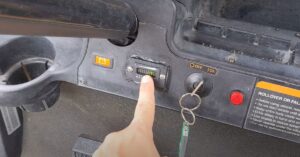How To Maintain Golf Cart Batteries?
Ever wondered why your golf cart battery doesn’t last as long as it should? Or perhaps you’re tired of frequently replacing them and burning a hole in your pocket. The key to longevity lies in proper maintenance!
Maintaining golf cart batteries is not rocket science. It’s all about regular cleaning, timely charging, and periodic water level checks. Just these simple steps can significantly increase the life of your batteries.
But how exactly do you go about it? And what are some common mistakes to avoid? Stick around for some easy-to-follow tips and tricks that will keep your golf cart running smoothly for longer!
Key Takeaways
- Regular maintenance is key: Properly maintaining your golf cart batteries through regular check-ups and cleaning is essential for their longevity and performance.
- Monitor water levels: Keeping a close eye on the water levels in your batteries and topping them up when necessary helps to prevent damage and extend their lifespan.
- Charge smartly: Following recommended charging practices, such as avoiding overcharging or letting the battery fully discharge, can significantly enhance the life of your golf cart batteries.
- Store with care: When not in use, store your golf cart batteries in a cool, dry place and ensure they are properly disconnected to avoid drainage or damage during periods of non-use.
How to Clean Golf Cart Batteries Properly?
Cleaning your golf cart batteries is an essential maintenance task that ensures optimal performance and extends their lifespan. Regular cleaning removes dirt, corrosion, and debris that can hinder the battery’s efficiency. Here are some simple steps to help you clean your golf cart batteries properly.
Safety first
Before you begin, make sure to wear protective gloves and goggles to shield yourself from any harmful chemicals or debris.
Disconnect the battery
Start by disconnecting the battery cables from the terminals. It’s important to remove the negative cable (black) first, followed by the positive cable (red).
Prepare a cleaning solution
Mix a solution of warm water and baking soda in a bucket or spray bottle. Aim for a ratio of 1 tablespoon of baking soda per liter of water.
Scrub gently
Dip a brush or sponge into the cleaning solution and scrub away any dirt or corrosion on the battery terminals, cables, and connectors. Be gentle while scrubbing to avoid damaging delicate parts.
Rinse thoroughly
Once you have cleaned all visible areas, rinse everything using clean water until no traces of baking soda remain.
Dry completely
After rinsing, use a cloth or towel to dry off any excess moisture on the battery components before reconnecting them.
By following these steps regularly – ideally every few months – you can keep your golf cart batteries in top condition and ensure reliable performance on the course.
What Are the Best Charging Practices for Golf Cart Batteries?
If you want to ensure optimal performance and longevity of your golf cart batteries, it is crucial to follow the best charging practices. Properly charging your batteries can save you from potential damage and costly replacements. So, let’s dig deeper into the recommended methods that will help you get the most out of your golf cart batteries.
Charge regularly
It is important to charge your golf cart batteries after each use, even if they are not completely drained. Regular charging prevents deep discharge and keeps the battery cells active and healthy.
Avoid overcharging
Overcharging can lead to electrolyte loss and excessive heat buildup in the battery, causing damage over time. Use a smart charger or set a timer to avoid leaving your batteries connected for too long.
Maintain proper voltage levels
Golf cart batteries operate at specific voltage levels, depending on their type (usually 36 or 48 volts). Make sure you use a charger compatible with your battery’s voltage rating to prevent undercharging or overcharging.
Keep an eye on temperature
Extreme temperatures can affect the performance of golf cart batteries during charging. Ideally, charge them in ambient temperatures between 50°F and 80°F (10°C – 27°C) for optimal results.
Clean battery terminals
Before connecting the charger, inspect and clean the battery terminals using a mixture of baking soda and water to remove corrosion or dirt build-up. This ensures better conductivity during charging.
How Often Should You Water Golf Cart Batteries?
Properly maintaining your golf cart batteries is essential for their longevity and performance. One crucial aspect of battery maintenance is ensuring they are adequately watered. So, how often should you water golf cart batteries? Let’s find out.
Golf cart batteries typically require watering every 30-45 days or whenever the water level drops below the recommended range. The frequency may vary depending on factors such as usage, climate conditions, and battery type. It’s important to note that under-watering or over-watering can both be detrimental to the battery’s health.
To determine when it’s time to water your golf cart batteries, visually inspect them regularly. Look for any signs of low water levels or exposed plates inside the cells. Additionally, consider investing in a hydrometer, a device that measures specific gravity in each cell to assess electrolyte levels accurately.
When watering your golf cart batteries, use distilled or deionized water and avoid tap water as it contains minerals that could damage the cells. Only fill each cell until the electrolyte covers the plates by about ¼ inch (6mm). Remember not to overfill as excessive electrolyte can spill during charging.
By monitoring your golf cart batteries’ visual indicators and following these guidelines for watering frequency and technique, you’ll ensure optimal performance and prolong their lifespan.
- Inspect visually for low water levels
- Invest in a hydrometer for accurate measurements
- Use distilled or deionized water instead of tap water
- Avoid overfilling each cell during watering
Why Is Regular Inspection of Battery Connections Important for Maintenance?
Regular inspection of battery connections is crucial for the proper maintenance of your battery. Neglecting this simple task can lead to various issues and potentially costly repairs down the line.
Firstly, regular inspection ensures that the battery connections are secure and tight. Over time, vibrations from driving can loosen these connections, leading to a poor electrical connection between the battery and the rest of your vehicle’s electrical system. By checking them regularly, you can identify any loose or corroded terminals and take immediate action.
Secondly, inspecting battery connections allows you to monitor their condition. Corrosion is a common problem that can occur due to exposure to moisture or chemicals present in the environment. This corrosion can hinder the flow of electricity, reducing the efficiency of your battery and potentially causing starting problems. Regular inspections help you catch corrosion early on so that you can clean it off promptly.
Furthermore, by inspecting battery connections regularly, you may also uncover signs of damage or wear on cables or connectors themselves. Exposed wires or fraying insulation could result in short circuits or even electrical fires if left unaddressed.
In addition, maintaining good battery connections contributes to overall vehicle safety by minimizing potential electrical issues while driving. A weak connection could cause intermittent power loss or voltage fluctuations that might affect critical systems like headlights, brake lights, or engine control modules.
Can Using a Battery Maintainer Extend the Lifespan of Your Golf Cart Batteries?
Using a Battery Maintainer to Extend the Lifespan of Your Golf Cart Batteries
Can using a battery maintainer extend the lifespan of your golf cart batteries? The answer is a resounding yes. Let’s dig deeper into why this simple device can make a significant difference in prolonging the life of your golf cart batteries.
Here are the reasons why using a battery maintainer is beneficial:
Prevents sulfation
Sulfation occurs when lead sulfate crystals build up on the battery plates, reducing its capacity and ability to hold a charge. A battery maintainer helps prevent sulfation by providing a slow, steady trickle charge that keeps the battery fully charged at all times.
Ensures optimal charging
Unlike traditional chargers that provide high voltage bursts, battery maintainers deliver a low-level current over an extended period. This gentle charging process prevents overcharging and minimizes heat buildup, which can damage the batteries.
Maintains battery health during storage
If you store your golf cart for an extended period, such as during winter months or offseasons, using a battery maintainer is crucial. It will keep your batteries in their best condition by providing them with just enough power to stay fully charged without overcharging them.
Saves money in the long run
By extending the lifespan of your golf cart batteries, you’ll save money on frequent replacements. Battery maintainers are relatively affordable compared to buying new batteries regularly.
FAQs
Q: How often should golf cart batteries be charged?
A: Golf cart batteries should be charged after each use to ensure maximum performance and longevity. Leaving the batteries discharged for extended periods can lead to sulfation, which can reduce their capacity over time.
Q: What is the importance of checking water levels in golf cart batteries?
A: Checking water levels in golf cart batteries is crucial as low water levels can cause damage to the battery plates and result in poor performance. Regularly adding distilled water to maintain proper levels helps prevent overheating and extends battery life.
Q: How should one clean golf cart battery terminals?
A: To clean golf cart battery terminals, mix a solution of baking soda and water and apply it to the terminals using a brush or cloth. Scrub away any corrosion or buildup, then rinse with clean water and dry thoroughly before reconnecting.
Q: Are there any storage tips for maintaining golf cart batteries during winter months?
A: During winter months when not in use, it’s important to store golf cart batteries fully charged. Keep them in a cool, dry place above freezing temperatures if possible. Periodically check the charge level throughout storage and recharge as needed to prevent deep discharge.




